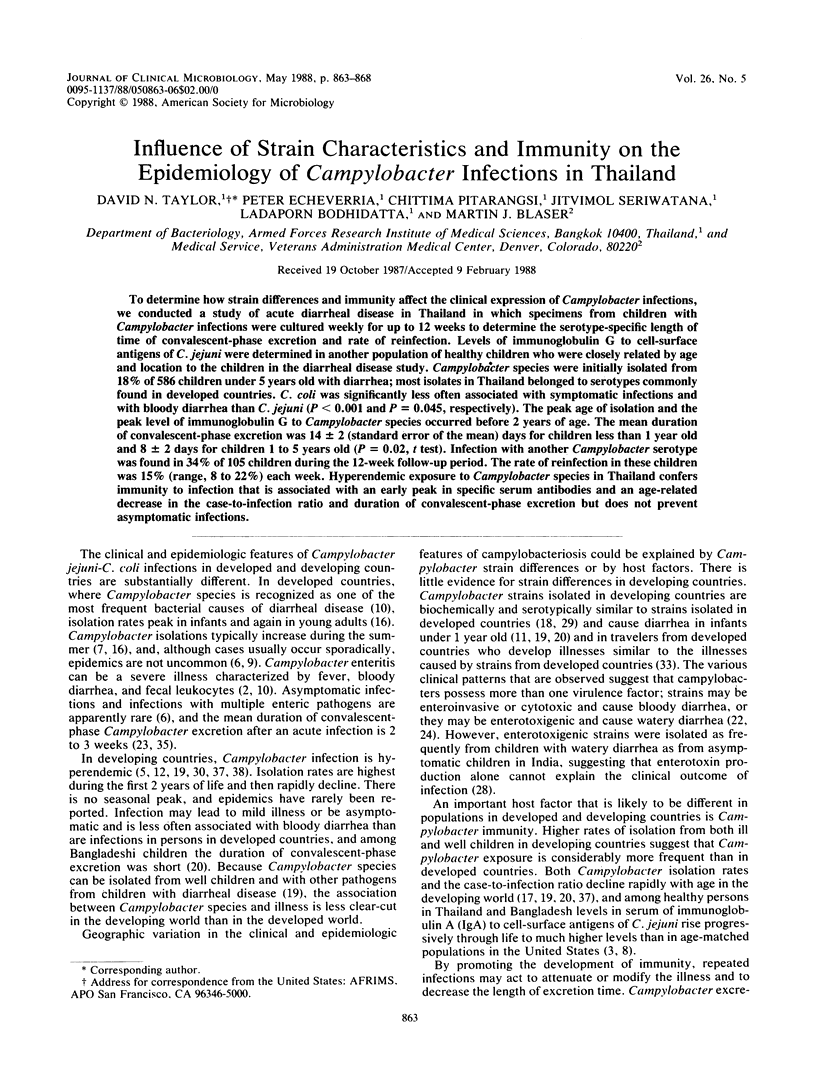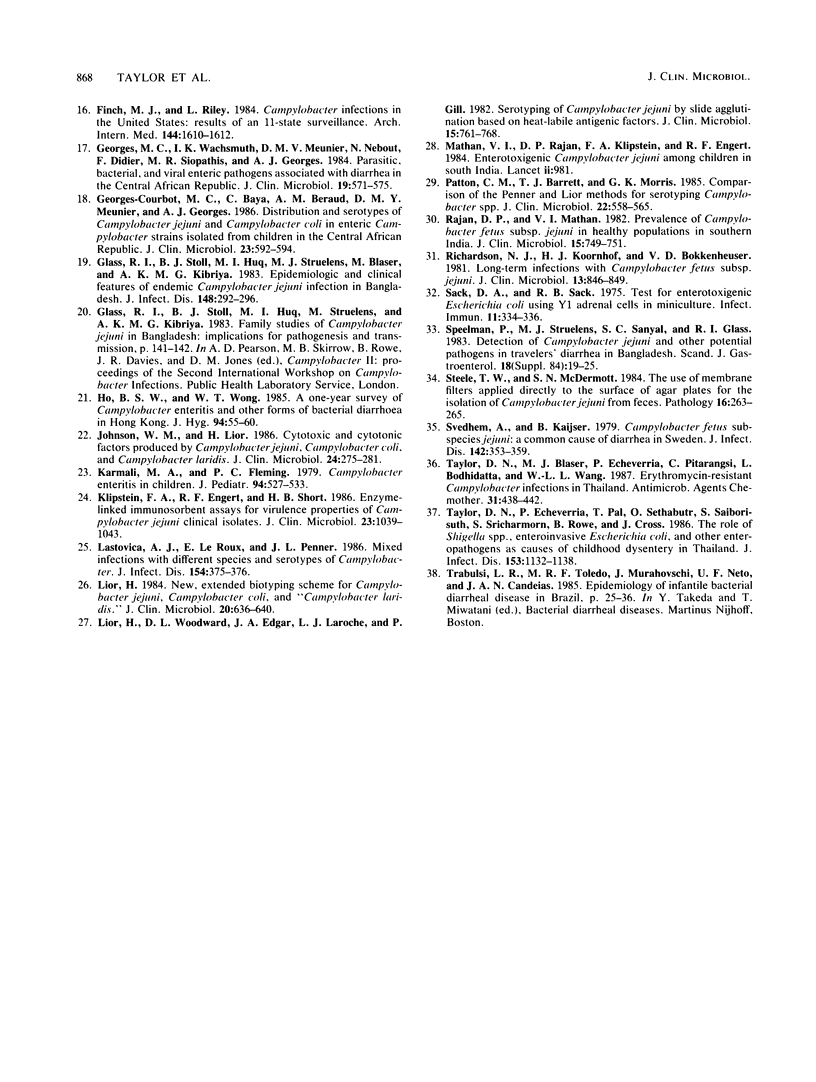Abstract
To determine how strain differences and immunity affect the clinical expression of Campylobacter infections, we conducted a study of acute diarrheal disease in Thailand in which specimens from children with Campylobacter infections were cultured weekly for up to 12 weeks to determine the serotype-specific length of time of convalescent-phase excretion and rate of reinfection. Levels of immunoglobulin G to cell-surface antigens of C. jejuni were determined in another population of healthy children who were closely related by age and location to the children in the diarrheal disease study. Campylobacter species were initially isolated from 18% of 586 children under 5 years old with diarrhea; most isolates in Thailand belonged to serotypes commonly found in developed countries. C. coli was significantly less often associated with symptomatic infections and with bloody diarrhea than C. jejuni (P less than 0.001 and P = 0.045, respectively). The peak age of isolation and the peak level of immunoglobulin G to Campylobacter species occurred before 2 years of age. The mean duration of convalescent-phase excretion was 14 +/- 2 (standard error of the mean) days for children less than 1 year old and 8 +/- 2 days for children 1 to 5 years old (P = 0.02, t test). Infection with another Campylobacter serotype was found in 34% of 105 children during the 12-week follow-up period. The rate of reinfection in these children was 15% (range, 8 to 22%) each week. Hyperendemic exposure to Campylobacter species in Thailand confers immunity to infection that is associated with an early peak in specific serum antibodies and an age-related decrease in the case-to-infection ratio and duration of convalescent-phase excretion but does not prevent asymptomatic infections.
Full text
PDF





Selected References
These references are in PubMed. This may not be the complete list of references from this article.
- Banfi E., Cinco M., Zabucchi G. Phagocytosis of Campylobacter jejuni and C. coli by peritoneal macrophages. J Gen Microbiol. 1986 Aug;132(8):2409–2412. doi: 10.1099/00221287-132-8-2409. [DOI] [PubMed] [Google Scholar]
- Blaser M. J., Berkowitz I. D., LaForce F. M., Cravens J., Reller L. B., Wang W. L. Campylobacter enteritis: clinical and epidemiologic features. Ann Intern Med. 1979 Aug;91(2):179–185. doi: 10.7326/0003-4819-91-2-179. [DOI] [PubMed] [Google Scholar]
- Blaser M. J., Black R. E., Duncan D. J., Amer J. Campylobacter jejuni-specific serum antibodies are elevated in healthy Bangladeshi children. J Clin Microbiol. 1985 Feb;21(2):164–167. doi: 10.1128/jcm.21.2.164-167.1985. [DOI] [PMC free article] [PubMed] [Google Scholar]
- Blaser M. J., Duncan D. J. Human serum antibody response to Campylobacter jejuni infection as measured in an enzyme-linked immunosorbent assay. Infect Immun. 1984 May;44(2):292–298. doi: 10.1128/iai.44.2.292-298.1984. [DOI] [PMC free article] [PubMed] [Google Scholar]
- Blaser M. J., Glass R. I., Huq M. I., Stoll B., Kibriya G. M., Alim A. R. Isolation of Campylobacter fetus subsp. jejuni from Bangladeshi children. J Clin Microbiol. 1980 Dec;12(6):744–747. doi: 10.1128/jcm.12.6.744-747.1980. [DOI] [PMC free article] [PubMed] [Google Scholar]
- Blaser M. J., Reller L. B. Campylobacter enteritis. N Engl J Med. 1981 Dec 10;305(24):1444–1452. doi: 10.1056/NEJM198112103052404. [DOI] [PubMed] [Google Scholar]
- Blaser M. J., Reller L. B., Luechtefeld N. W., Wang W. L. Campylobacter enteritis in Denver. West J Med. 1982 Apr;136(4):287–290. [PMC free article] [PubMed] [Google Scholar]
- Blaser M. J., Taylor D. N., Echeverria P. Immune response to Campylobacter jejuni in a rural community in Thailand. J Infect Dis. 1986 Feb;153(2):249–254. doi: 10.1093/infdis/153.2.249. [DOI] [PubMed] [Google Scholar]
- Blaser M. J., Taylor D. N., Feldman R. A. Epidemiology of Campylobacter jejuni infections. Epidemiol Rev. 1983;5:157–176. doi: 10.1093/oxfordjournals.epirev.a036256. [DOI] [PubMed] [Google Scholar]
- Blaser M. J., Wells J. G., Feldman R. A., Pollard R. A., Allen J. R. Campylobacter enteritis in the United States. A multicenter study. Ann Intern Med. 1983 Mar;98(3):360–365. doi: 10.7326/0003-4819-98-3-360. [DOI] [PubMed] [Google Scholar]
- Bokkenheuser V. D., Richardson N. J., Bryner J. H., Roux D. J., Schutte A. B., Koornhof H. J., Freiman I., Hartman E. Detection of enteric campylobacteriosis in children. J Clin Microbiol. 1979 Feb;9(2):227–232. doi: 10.1128/jcm.9.2.227-232.1979. [DOI] [PMC free article] [PubMed] [Google Scholar]
- Burke V., Gracey M., Robinson J., Peck D., Beaman J., Bundell C. The microbiology of childhood gastroenteritis: Aeromonas species and other infective agents. J Infect Dis. 1983 Jul;148(1):68–74. doi: 10.1093/infdis/148.1.68. [DOI] [PubMed] [Google Scholar]
- Dean A. G., Ching Y. C., Williams R. G., Harden L. B. Test for Escherichia coli enterotoxin using infant mice: application in a study of diarrhea in children in Honolulu. J Infect Dis. 1972 Apr;125(4):407–411. doi: 10.1093/infdis/125.4.407. [DOI] [PubMed] [Google Scholar]
- Doyle M. P., Roman D. J. Recovery of Campylobacter jejuni and Campylobacter coli from inoculated foods by selective enrichment. Appl Environ Microbiol. 1982 Jun;43(6):1343–1353. doi: 10.1128/aem.43.6.1343-1353.1982. [DOI] [PMC free article] [PubMed] [Google Scholar]
- Echeverria P., Seriwatana J., Taylor D. N., Yanggratoke S., Tirapat C. A comparative study of enterotoxigenic Escherichia coli, Shigella, Aeromonas, and Vibrio as etiologies of diarrhea in northeastern Thailand. Am J Trop Med Hyg. 1985 May;34(3):547–554. doi: 10.4269/ajtmh.1985.34.547. [DOI] [PubMed] [Google Scholar]
- Finch M. J., Riley L. W. Campylobacter infections in the United States. Results of an 11-state surveillance. Arch Intern Med. 1984 Aug;144(8):1610–1612. [PubMed] [Google Scholar]
- Georges-Courbot M. C., Baya C., Beraud A. M., Meunier D. M., Georges A. J. Distribution and serotypes of Campylobacter jejuni and Campylobacter coli in enteric Campylobacter strains isolated from children in the Central African Republic. J Clin Microbiol. 1986 Mar;23(3):592–594. doi: 10.1128/jcm.23.3.592-594.1986. [DOI] [PMC free article] [PubMed] [Google Scholar]
- Georges M. C., Wachsmuth I. K., Meunier D. M., Nebout N., Didier F., Siopathis M. R., Georges A. J. Parasitic, bacterial, and viral enteric pathogens associated with diarrhea in the Central African Republic. J Clin Microbiol. 1984 May;19(5):571–575. doi: 10.1128/jcm.19.5.571-575.1984. [DOI] [PMC free article] [PubMed] [Google Scholar]
- Glass R. I., Stoll B. J., Huq M. I., Struelens M. J., Blaser M., Kibriya A. K. Epidemiologic and clinical features of endemic Campylobacter jejuni infection in Bangladesh. J Infect Dis. 1983 Aug;148(2):292–296. doi: 10.1093/infdis/148.2.292. [DOI] [PubMed] [Google Scholar]
- Ho B. S., Wong W. T. A one-year survey of campylobacter enteritis and other forms of bacterial diarrhoea in Hong Kong. J Hyg (Lond) 1985 Feb;94(1):55–60. doi: 10.1017/s002217240006112x. [DOI] [PMC free article] [PubMed] [Google Scholar]
- Johnson W. M., Lior H. Cytotoxic and cytotonic factors produced by Campylobacter jejuni, Campylobacter coli, and Campylobacter laridis. J Clin Microbiol. 1986 Aug;24(2):275–281. doi: 10.1128/jcm.24.2.275-281.1986. [DOI] [PMC free article] [PubMed] [Google Scholar]
- Karmali M. A., Fleming P. C. Campylobacter enteritis in children. J Pediatr. 1979 Apr;94(4):527–533. doi: 10.1016/s0022-3476(79)80004-9. [DOI] [PubMed] [Google Scholar]
- Klipstein F. A., Engert R. F., Short H. B. Enzyme-linked immunosorbent assays for virulence properties of Campylobacter jejuni clinical isolates. J Clin Microbiol. 1986 Jun;23(6):1039–1043. doi: 10.1128/jcm.23.6.1039-1043.1986. [DOI] [PMC free article] [PubMed] [Google Scholar]
- Lastovica A. J., Le Roux E., Penner J. L. Mixed infections with different species and serotypes of Campylobacter. J Infect Dis. 1986 Aug;154(2):375–375. doi: 10.1093/infdis/154.2.375. [DOI] [PubMed] [Google Scholar]
- Lior H. New, extended biotyping scheme for Campylobacter jejuni, Campylobacter coli, and "Campylobacter laridis". J Clin Microbiol. 1984 Oct;20(4):636–640. doi: 10.1128/jcm.20.4.636-640.1984. [DOI] [PMC free article] [PubMed] [Google Scholar]
- Lior H., Woodward D. L., Edgar J. A., Laroche L. J., Gill P. Serotyping of Campylobacter jejuni by slide agglutination based on heat-labile antigenic factors. J Clin Microbiol. 1982 May;15(5):761–768. doi: 10.1128/jcm.15.5.761-768.1982. [DOI] [PMC free article] [PubMed] [Google Scholar]
- Mathan V. I., Rajan D. P., Klipstein F. A., Engert R. F. Enterotoxigenic Campylobacter jejuni among children in South India. Lancet. 1984 Oct 27;2(8409):981–981. doi: 10.1016/s0140-6736(84)91193-0. [DOI] [PubMed] [Google Scholar]
- Patton C. M., Barrett T. J., Morris G. K. Comparison of the Penner and Lior methods for serotyping Campylobacter spp. J Clin Microbiol. 1985 Oct;22(4):558–565. doi: 10.1128/jcm.22.4.558-565.1985. [DOI] [PMC free article] [PubMed] [Google Scholar]
- Rajan D. P., Mathan V. I. Prevalence of Campylobacter fetus subsp. jejuni in healthy populations in southern India. J Clin Microbiol. 1982 May;15(5):749–751. doi: 10.1128/jcm.15.5.749-751.1982. [DOI] [PMC free article] [PubMed] [Google Scholar]
- Richardson N. J., Koornhof H. J., Bokkenheuser V. D. Long-term infections with Campylobacter fetus subsp. jejuni. J Clin Microbiol. 1981 May;13(5):846–849. doi: 10.1128/jcm.13.5.846-849.1981. [DOI] [PMC free article] [PubMed] [Google Scholar]
- Sack D. A., Sack R. B. Test for enterotoxigenic Escherichia coli using Y-1 adrenal cells in miniculture. Infect Immun. 1975 Feb;11(2):334–336. doi: 10.1128/iai.11.2.334-336.1975. [DOI] [PMC free article] [PubMed] [Google Scholar]
- Speelman P., Struelens M. J., Sanyal S. C., Glass R. I. Detection of Campylobacter jejuni and other potential pathogens in travellers' diarrhoea in Bangladesh. Scand J Gastroenterol Suppl. 1983;84:19–23. [PubMed] [Google Scholar]
- Steele T. W., McDermott S. N. The use of membrane filters applied directly to the surface of agar plates for the isolation of Campylobacter jejuni from feces. Pathology. 1984 Jul;16(3):263–265. doi: 10.3109/00313028409068535. [DOI] [PubMed] [Google Scholar]
- Svedhem A., Kaijser B. Campylobacter fetus subspecies jejuni: a common cause of diarrhea in Sweden. J Infect Dis. 1980 Sep;142(3):353–359. doi: 10.1093/infdis/142.3.353. [DOI] [PubMed] [Google Scholar]
- Taylor D. N., Blaser M. J., Echeverria P., Pitarangsi C., Bodhidatta L., Wang W. L. Erythromycin-resistant Campylobacter infections in Thailand. Antimicrob Agents Chemother. 1987 Mar;31(3):438–442. doi: 10.1128/aac.31.3.438. [DOI] [PMC free article] [PubMed] [Google Scholar]
- Taylor D. N., Echeverria P., Pál T., Sethabutr O., Saiborisuth S., Sricharmorn S., Rowe B., Cross J. The role of Shigella spp., enteroinvasive Escherichia coli, and other enteropathogens as causes of childhood dysentery in Thailand. J Infect Dis. 1986 Jun;153(6):1132–1138. doi: 10.1093/infdis/153.6.1132. [DOI] [PubMed] [Google Scholar]


